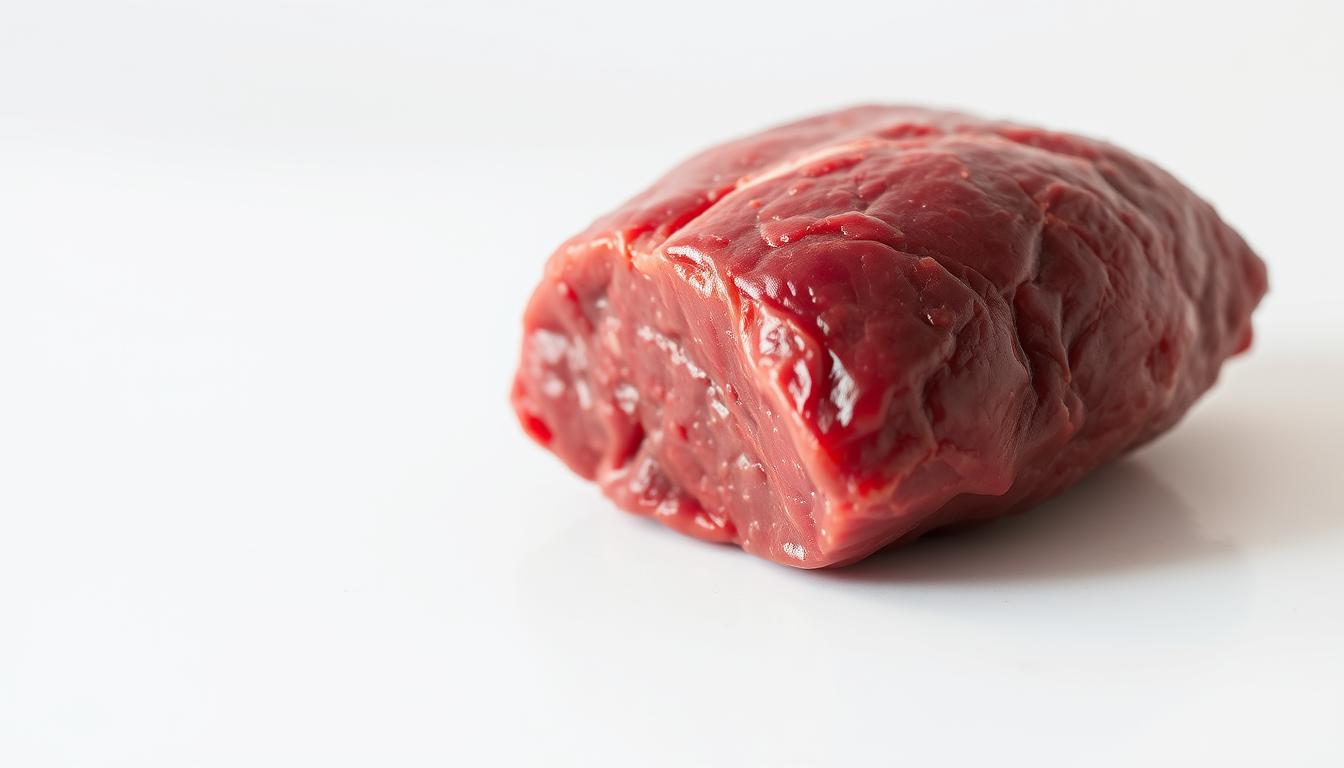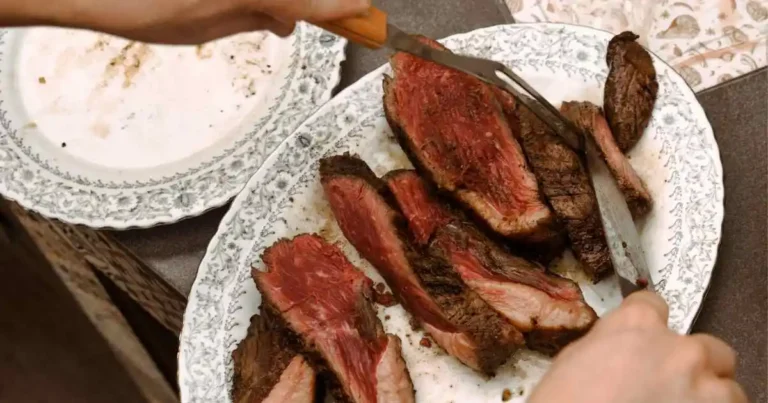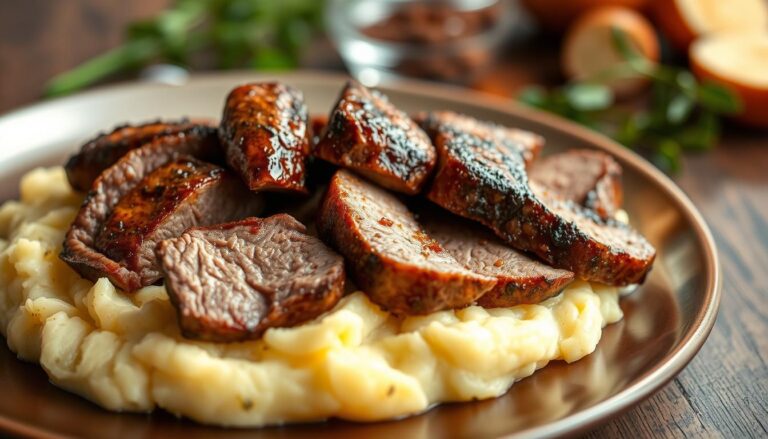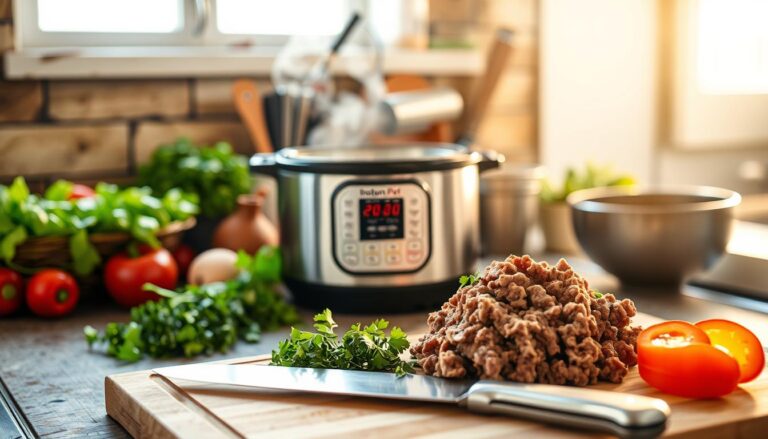Tasty Beef Liver Recipes You’ll Love
You may have avoided this ingredient for years, but tonight you can change that with simple steps that build confidence and comfort at the stove.
Start small: learn a Southern sear with gravy, an Italian Marsala pan sauce, or a quick flourless skillet method that keeps textures tender.
Each approach shows clear timing, basic equipment, and how to tame metallic notes by soaking in milk. You’ll also see how onions, garlic, butter, and a deglaze pull savory depth from the pan.
What you gain: practical timing tips to avoid overcooking, smart swaps like mashed cauliflower, and storage tricks so leftovers stay moist submerged in gravy.
By the end of this post you’ll feel ready to cook tonight with repeatable technique and real flavor that honors tradition and modern plates.
Why you’ll love cooking beef liver right now
If you want big nutrition in small portions, liver makes an easy, fast choice.
Nutrient-dense and budget-friendly: A modest serving delivers vitamin A, B12, iron, selenium, and copper while staying relatively low in calories. That makes it a solid way to boost daily micronutrients without overspending.
Fast, flexible, and keto-friendly: You get high protein and very low carbs, so the cut fits low-carb plans. Pair it with fiber-rich greens to round out a balanced plate.
Taste options and simple tricks: Choose calf cuts for a milder profile or soak mature slices in milk to reduce metallic notes. Quick sears take minutes, yet the result feels hearty and comforting.
“Treat liver like any prized cut: pat dry, heat a heavy pan, and sear quickly to lock in tenderness.”
| Feature | Calf option | Mature option |
|---|---|---|
| Flavor | Milder, gentler | Stronger, more mineral |
| Prep tip | Quick sear, light seasoning | Milk soak to tame bitterness |
| Best use | Weeknight mains | Bold sauces and gravies |
- You’ll hit protein goals with small portions.
- You’ll enjoy fast cooking that adapts to many cuisines.
- You’ll keep costs low while delivering big flavor when you use right techniques.
Beef liver essentials: cuts, flavors, and pantry staples
Start by knowing the cuts and pantry picks that make liver night simple and reliable.
Choosing calf or mature cuts
Calf cuts are milder and easier to welcome at the table. Choose them if you want a gentler taste and quicker cook time.
Older beef cuts have stronger mineral notes. A 1–2 hour milk soak will soften metallic flavors and make the slices more approachable.
Seasonings, onions, and garlic
Build a simple spice mix with onion powder, garlic powder, paprika, salt, and black pepper. These accents lift richness without hiding it.
Start cooking by gently sweating sliced onions and a little fresh garlic to create a sweet, savory base before a fast sear.
Fats, pans, and prep
Pick olive oil for a clean finish or butter for rounded flavor. Neutral high-heat fats like peanut oil or bacon grease speed browning.
A large skillet or cast iron holds heat and prevents steaming. Trim connective tissue, pat slices dry, and preheat the pan so you get an even sear.
| Item | Why it matters | Tip |
|---|---|---|
| Calf cut | Milder flavor | Quick sear, light seasoning |
| Mature cut | Stronger, mineral notes | Milk soak 1–2 hrs, bold spice |
| Large skillet | Even heat, less steaming | Preheat until hot, then add fat |
- Set sliced onion, measured spices, and chosen fat within reach.
- Pat dry to aid browning and reduce splatter.
- Keep stock, wine, or herbs nearby to finish a quick pan sauce.
Prep that makes a difference: soak, pat dry, season
Start small and smart: a brief soak and careful handling set you up for even browning and tender results.
Soaking to tame strong notes
Soak mature cuts in milk for 1–2 hours to mellow metallic flavor. Calf cuts are milder and often skip this step.
After soaking, lift the slices gently and move to the next step without delay.
Pat dry, light dredge, and gentle handling
You’ll pat dry each piece thoroughly so the surface browns. If the meat is wet, fat will sputter and you lose color.
Handle slices with care; they tear easily. A light dredge in seasoned flour adds structure and helps create fond for gravy later.
“Reserve a couple of tablespoons of that seasoned flour — it makes pan gravy simple and trims waste.”
Seasoning and staging
Season with a pinch of salt and pepper plus onion powder, garlic powder, and paprika. Keep your prep staged so the surface stays dry between steps.
- Arrange liver slices in a single layer on a tray to avoid tearing.
- Reserve a few tablespoons of dredge if you plan a Southern-style gravy.
- Avoid over-seasoning early; adjust at the gravy stage instead.
Southern-style liver and onions with gravy
A classic Southern skillet makes a deeply savory gravy that turns simple cuts into a comforting weeknight supper.
Quick sear and onion base
Dredge slices in seasoned flour (flour, salt, black pepper, onion powder, garlic powder, paprika). Heat a neutral oil like peanut oil until shimmering, then sear about 3–4 minutes per side to get bronzed edges while keeping the interior tender.
Build the gravy
Remove the meat and sauté onions in the same pan, scraping browned bits to collect flavor. Sprinkle in 2 tablespoons of the reserved flour and cook briefly to remove the raw taste.
Whisk in water and a splash of milk until smooth, then nestle the liver pieces back into the sauce. Simmer until the gravy thickens and coats the meat.
“Rest the dish a few minutes so the gravy settles and every bite stays moist.”
| Step | Time | Key note |
|---|---|---|
| Dredge | 5 minutes | Seasoned flour, light coating |
| Sear | 3–4 minutes per side | Hot oil, bronzed edges |
| Gravy | 5–8 minutes | Reserved flour, water, milk |
Italian-style beef liver with Marsala
A quick Marsala deglaze adds nutty sweetness and depth to a fast, saucy skillet dish.
Start by sweating sliced onions and minced garlic in 1 tablespoon olive oil plus 1 tablespoon butter until soft and golden. Remove the aromatics and set them aside.
Pat liver pieces dry, then sear in the hot skillet about 1–2 minutes per side to keep centers tender and slightly rosy. Work quickly to avoid overcooking.
Deglaze the pan with 1/4 cup Marsala, scraping the fond. Add 1 cup stock, 1 tablespoon balsamic, and a sprig of thyme. Reduce 3–4 minutes until slightly syrupy.
Finish by stirring in a knob of butter and a few tablespoons heavy cream for a silky sauce. Return the aromatics and nestle the slices back to warm through. Garnish with chopped parsley.
| Step | Amount | Timing |
|---|---|---|
| Sweat aromatics | 1 tbsp olive + 1 tbsp butter | Until golden (3–5 minutes) |
| Sear slices | Dry liver pieces | 1–2 minutes per side |
| Deglaze & reduce | 1/4 cup Marsala, 1 cup stock | 3–4 minutes |
| Finish | Butter + a few tablespoons cream | Warm, then serve |
- Serve with mashed potatoes, polenta, or crusty bread to catch the sauce.
- Swap Marsala with dry white wine plus a splash of brandy, Madeira, or dry sherry if needed.
- Keep it gluten-free by skipping flour or using a cornstarch slurry to thicken.
“Swirl in cream at the end so the sauce stays glossy and the slices stay tender.”
Simple skillet beef liver and onions without flour
A hot skillet and bold seasoning turn a simple pan into a fast, flavor-forward weeknight dish. This no-flour method keeps the plate gluten-free and low-carb while letting the meat’s natural richness shine.
Season well: mix garlic powder, onion powder, smoked paprika, black pepper, and salt. If using mature beef, soak in milk 1–2 hours, then pat dry before seasoning to mellow any strong notes.
Prep and pan work
Sauté sliced onions in olive oil until golden, then remove and hold. Heat a heavy skillet until very hot and add enough fat to coat the pan.
Timing to avoid rubbery texture
Lay seasoned slices in the pan and cook about 3–5 minutes per side, depending on thickness. Aim for slightly pink centers; overcooking makes the meat tough.
- Serve immediately with the onions spooned on top and a sprinkle of parsley.
- Pair with mashed cauliflower, keto rice, or green beans sautéed in a little bacon grease for a filling, low-carb meal.
- Monitor doneness by touch or a quick cut—tender and slightly rosy is the goal.
“Keep heat high, time each side, and let seasoning do the heavy lifting.”
Best recipes for beef liver: timing, heat, and doneness
Doneness hinges on heat control and quick checks rather than long cook time. You’ll use medium-high heat and a fully preheated pan so the surface browns fast while the interior stays tender.
Medium-high heat, hot pan, and oil choice
Choose oil by method: use a neutral, high-heat oil when frying and olive oil plus butter for sautéing to build flavor. Preheat the pan until it’s very hot and shimmering before adding fat.
Per side cooking time by slice thickness
Match minutes per side to thickness. Thin slices need about 1–2 minutes per side (Italian style). Standard cuts run roughly 3–5 minutes per side (Southern and simple skillet).
If dredged, the crust forms faster; shave off 30–60 seconds to avoid overcooking.
How to check doneness without overcooking
Aim for a slight pink center. Use touch and visual cues: a tender give and faint blush mean juicy, not dry.
If uncertain, cut a small piece to check color. A thermometer can read 160°F, but many cooks prefer the visual method to avoid a well-done result.
- Don’t crowd the pan — work in batches so the temperature stays high.
- Let slices rest a few minutes so juices redistribute before serving.
- Keep sauces hot and ready so you finish quickly and keep texture soft.
“Watch the sizzle and trust a 30‑second tweak more than a long finish.”
| Method | Minutes per side | Oil |
|---|---|---|
| Italian (fast sear) | 1–2 minutes | Olive oil + butter |
| Southern (dredged) | 3–4 minutes | Neutral frying oil |
| Simple skillet | 3–5 minutes | Olive oil or bacon fat |
What to serve on the side
Choose accompaniments that balance richness with bright, textured bites. Pick comforting starches that soak up gravy or Marsala sauce and add a warm base to the plate.
Starchy options: creamy mashed potatoes, soft polenta, or a warm crusty bread work especially well. Mashed potatoes pair with gravy and herbs; polenta adds a silky contrast.
Veg and greens: sautéed greens, steamed green beans, or roasted vegetables bring color and freshness. A quick toss in olive oil and a pinch of salt highlights natural sweetness without masking the main dish.
- You’ll pick comforting sides that soak up sauces, like creamy mashed potatoes, polenta, or a warm crusty bread.
- You’ll add color with sautéed greens, green beans, or roasted vegetables to balance richness.
- You’ll keep low-carb swaps handy—mashed cauliflower or keto rice—so the plate stays satisfying without excess starch.
| Side type | Best match | Why it works |
|---|---|---|
| Mashed potatoes | Southern gravy | Soaks sauce, adds creamy mouthfeel |
| Creamy polenta | Marsala sauce | Silky texture pairs with sweet-savory reduction |
| Sautéed greens | No-flour skillet dish | Adds fiber and bright contrast |
Nutritional spotlight: iron, protein, and more
This cut packs a nutritional punch: high vitamins and readily absorbed iron in a compact serving. Small portions give you dense nourishment without many calories, so a little goes a long way.
Why it is rich in vitamin A, B12, and bioavailable iron
Vitamin A and B12 appear in striking amounts, supporting vision and nerve health. The iron is highly bioavailable, which helps energy and oxygen delivery more efficiently than many plant sources.
Protein powerhouse with low calories
You get solid protein in a modest portion while keeping calories low. This makes the cut a practical choice when you want nutrient density without excess volume.
Pairing with fiber-rich sides to balance the plate
There’s almost no dietary fiber in the meat, so add leafy greens, roasted vegetables, or citrus-sprinkled salad to supply fiber and vitamin C.
Tips to maximize benefits:
- You’ll boost iron absorption by adding a squeeze of lemon or orange alongside the plate.
- You’ll keep carbs low naturally, making the dish keto-friendly when paired with nonstarchy sides.
- You’ll let simple seasonings enhance flavor while preserving nutrients.

Tools and techniques that elevate flavor
A heavy, well-heated pan is the secret to a brown crust and even doneness every time. Small steps before you cook make a big difference in final flavor.
Choose the right cookware
Reach for a cast iron or other large skillet to hold steady heat and give reliable browning. A heavy skillet reduces hot spots so slices sear rather than steam.
Prep and basic steps
Pat dry any pieces after a milk soak to prevent steaming and to help the surface brown quickly. Dry surfaces form a better crust and keep texture tender.
Sauté sliced onion and minced garlic first to build a sweet, savory base. Use olive oil plus butter for layered taste, or a neutral oil like peanut if you need higher heat.
- Preheat until the pan is very hot, then add just enough oil to coat lightly.
- Dial the heat down a touch after the initial sear to avoid overcooking.
- Deglaze with stock or wine to capture the fond and make a quick sauce or gravy.
- Use a thin turner for gentle flipping and let slices rest briefly off heat to keep juices.
| Use | Oil choice | Why it works |
|---|---|---|
| High-heat fry | Peanut oil | High smoke point, fast browning |
| Sauté with aromatics | Olive oil + butter | Layered flavor and glossy finish |
| Gluten-free pan sauce | Olive oil | Gentle flavor, easy deglaze |
“Good tools and staged prep turn simple pan work into something impressively rich.”
Storage, leftovers, and reheating
Proper storage and gentle reheating keep this dish tasting like it did the first night. Treat leftovers with care so the texture and sauce stay appealing. Store slices submerged in gravy when you can; that extra liquid helps preserve moisture and flavor.
Fridge life, airtight containers, and gravy to hold moisture
Refrigerate in airtight containers and keep the meat covered with sauce. Stored this way, expect 3–4 days of best quality and safety.
If you plan to freeze, portion into meal-sized packs first. Frozen cooked meat will work in a pinch but may lose a bit of tenderness. Fresh or recently cooked gives the best texture when reheated.
How to reheat gently on the stovetop or microwave
Reheat slowly and avoid high heat. Warm the onions and sauce in a pan on low, add a splash of stock or water if the gravy is thick, then tuck the slices back in just to warm through.
If using a microwave, heat in short bursts of about 30–45 seconds, stir between intervals, and check doneness. This helps prevent a rubbery result.
“Revive the sauce first, then warm the meat briefly so the texture stays tender.”
- Store leftovers submerged in gravy in airtight containers to keep them moist.
- Expect 3–4 days of fridge life for best quality and safety.
- Reheat low and slow on the stovetop; add a splash of liquid if needed.
- Use short microwave bursts, stirring between intervals to avoid toughness.
- Portion into single servings so you only reheat what you will eat at one time.
- Freezing is possible but may affect texture; prioritize fresh for best tenderness.
| Task | Method | Timing / Note |
|---|---|---|
| Fridge storage | Airtight container, submerged in gravy | 3–4 days |
| Reheat on stovetop | Low heat, sauce first, add splash of stock | 5–8 minutes depending on portion |
| Microwave | Short bursts, stir between intervals | 30–45 seconds per burst |
| Freezing | Portion, freeze in airtight packs | 3 months best; texture may change |
Substitutions, variations, and helpful notes
Choosing a milder cut or a faster-cooking option keeps weeknight dinners both simple and reliable. Use small swaps to change texture and timing without new technique.
Key swaps to try:
- You can pick veal for a gentler taste, or chicken livers when you want a softer texture and much faster cook time.
- Go gluten-free by skipping flour or using a cornstarch slurry to thicken sauces.
- Choose chicken or beef stock depending on whether you want a lighter or more robust sauce base.
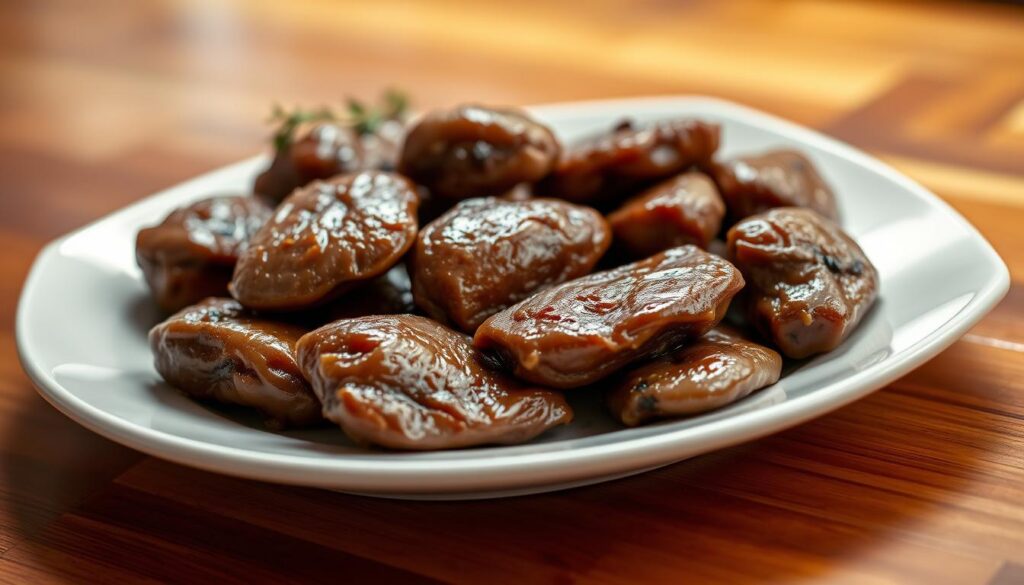
Wine, stock, and seasoning notes
Swap Marsala with dry white plus a splash of brandy, or try Madeira or dry sherry for depth. Use olive oil when sautéing aromatics and finish seasoning—add salt and pepper near the end so taste is balanced.
| Swap | Why | Timing note |
|---|---|---|
| Veal | Milder profile | Similar timing, slightly less soak |
| Chicken livers | Smaller, tender | Cook quickly—watch closely |
| Gluten-free thickener | Cornstarch | Mix with cold liquid, add at end |
“If you link to tools or pans, clearly state any affiliate links so readers know you may earn a small commission.”
Rotate these ideas to keep each liver recipe bright and approachable. Note how each type reacts to heat and adjust tablespoons or teaspoon measurements as you scale the batch.
Conclusion
Short habits make a big difference. Sear briefly in a hot pan, pat pieces dry, and rest them a few minutes to keep texture tender and sauces glossy.
You’ve seen three clear paths — Southern gravy, Marsala pan sauce, and a flourless skillet — that turn humble cuts into welcome weeknight meals. Use a milk soak to tame stronger notes, rely on onions and garlic for depth, and choose sides that catch sauce like mashed potatoes or roasted greens.
These easy recipes for beef liver help you cook with confidence tonight and next week. Keep timing tight, taste as you finish, and enjoy the nutrition—iron and B12—in every modest serving.

